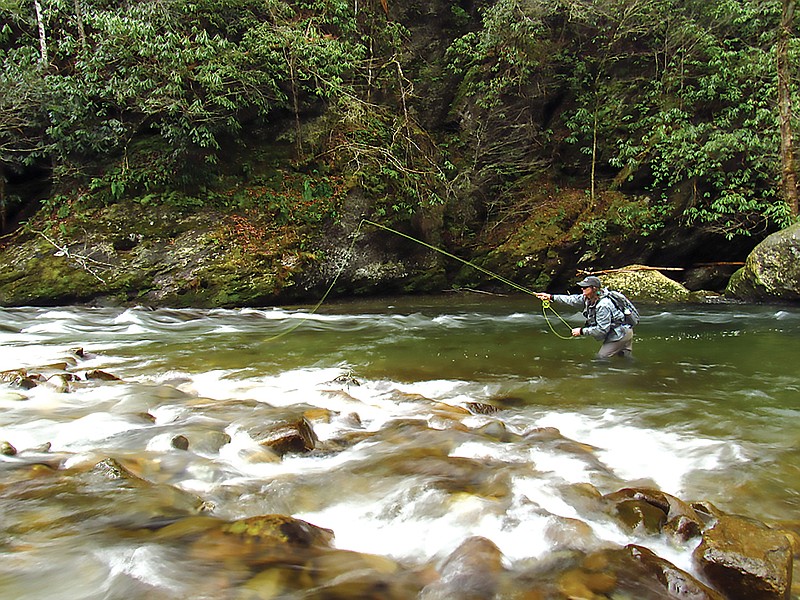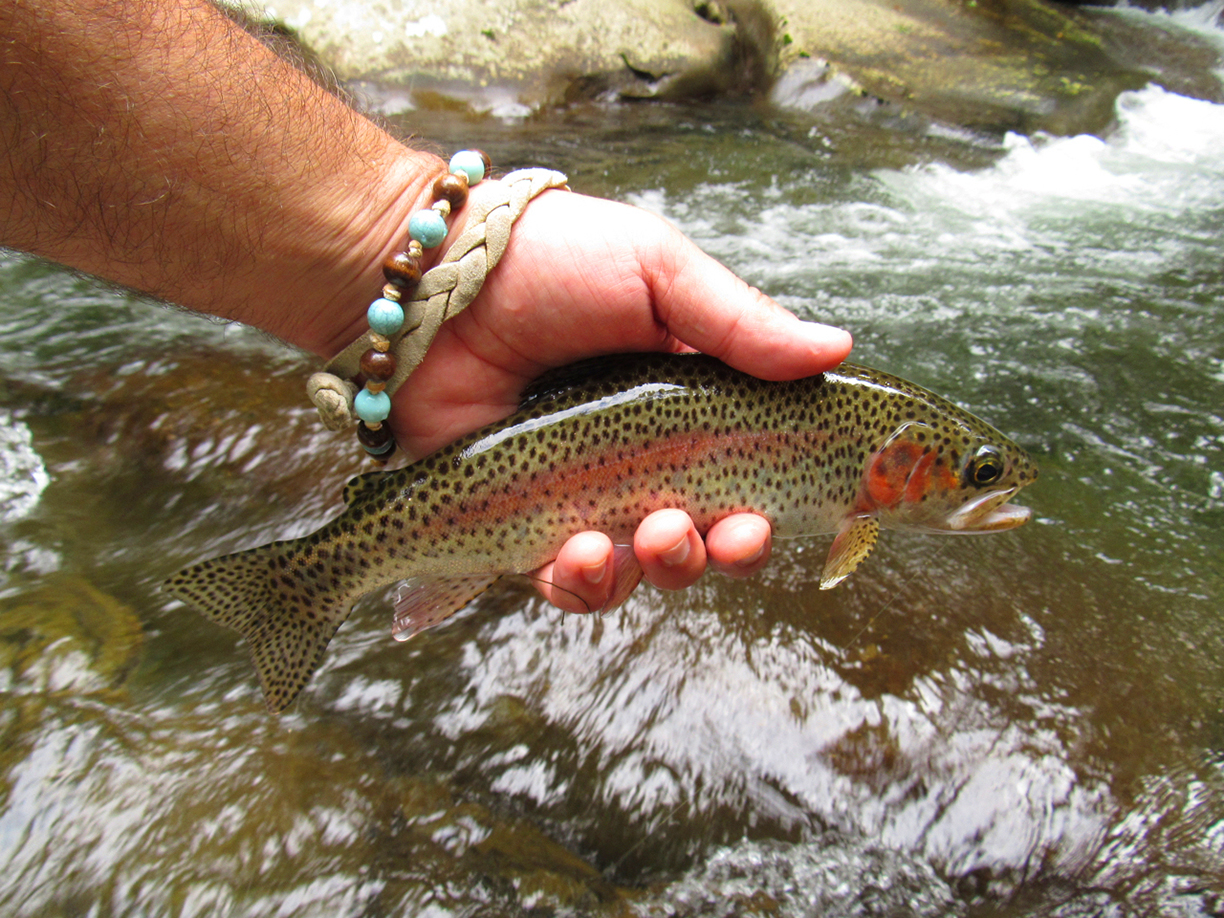Fly fishing Great Smoky Mountains National Park is less about catching big fish and more about experiences and the places it takes you.
Just ask Ian Rutter. He and his wife, Charity, run R&R Fly Fishing out of Townsend, Tennessee. They've guided anglers in the park for a quarter century, and Ian's voice still lights up when discussing opportunities for spring in the Smokies. He's excited about fishing, and he's also excited about getting into the park ahead of the busy tourist season.
Perhaps optimism is a side effect of living minutes away from some of the most gorgeous trout water in the country. There are more than 800 miles of wild trout streams within Great Smoky Mountains National Park. From roadside rivers to high-elevation rills holding native brook trout, there's more water than you could explore in a lifetime.
In early spring, Ian suggests anglers stick to larger waters at lower elevations. In March, and even into April, it's likely there will still be snow on the ground and ice on the edges of small streams up in the hills. Trout thrive in cold water, but their metabolisms slow, and they feed less readily in icy conditions. Also, the bugs they feed on are mostly dormant, which can make things kind of slow for fly fishing.
Meanwhile, down in the valleys, larger rivers like Little River, Deep Creek and the Oconaluftee will be waking up in March, and they'll be fishing very well headed into the latter part of spring. In the afternoons, even on cold days, fish should be looking to the surface for hatches of mayflies like Quill Gordons, blue-winged olives and blue quills. Throw in a few early brown stoneflies, and you'll see why the Smokies are known for great dry fly fishing.
"Oftentimes you'll have some combination of those bugs all at the same time," Ian says. "They're not too particular. And even the ones that are particular aren't as particular as some folks think they are."
He suggests loading a fly box with size 12 Adams patterns. He likes the parachute version for its high-floating visibility. For the smaller mayflies, you'll need some smaller, darker mayfly patterns down to size 18. The stoneflies should be mimicked with a size 12 to 14 orange Stimulator or an Elk Hair Caddis in brown or orange. One of the great things about the Stimulator is it's buoyant enough to fish in tandem with a small nymph, perhaps a Pheasant Tail, Hare's Ear or Prince.
Stealth and Expectations
"Being sneaky is even more important than fly selection," Ian warns.
Other than ongoing projects to reclaim waters for native brook trout, there are no trout stocked within the boundaries of Great Smoky Mountains National Park. The fish are wild and stream-born, and while they might be forced to feed opportunistically in relatively infertile waters, they are extremely wary of predators.
Since one misstep or errant cast will send fish scattering for cover, Ian suggests wading very carefully and making short, accurate casts instead of airing out line and spooking fish between you and the head of a run. Managing your drift is also easier with less line out, which is important because wild fish normally won't eat a bug if it's not drifting naturally in the current.
Another thing about trout in the Smokies is they grow slowly.
"I like to say, 'your results may vary,'" Ian says when asked about angler expectations. "We do catch some 16-inchers, but the important thing to remember is it's a wild trout fishery. There aren't any stocked trout that were put in last week at 14 inches. A 16-incher might be 10 years old. It's survived every type of predator out there, so it's super-smart and difficult to catch."
A proficient angler can expect to catch good numbers of brightly colored 8- to 10-inch wild trout. Any angler can expect to wade through some of the most gorgeous, cascading mountain trout water in the East.
The Experience
Ian and Charity both work full time as guides, and like many of us, family time with the kids comes at a premium. With this in mind, Ian suggests three destinations in the park where anglers can fish and spend time with non-fishing friends or family who would rather take a hike. Mid-March through April is prime wildflower season in the park.
Little River at Elkmont, Tenn.
Just east of Townsend, Little River is one of the largest streams in the park. It runs roadside for several miles along Little River Gorge Road, but it is accessible only by foot above Elkmont Campground.
Little River Trail departs from Elkmont and follows the river for 4.8 easy miles along a wide, mostly flat old railroad bed. The gravel path is perfect for beginners and families, and there's no need for any special gear other than maybe a snack and a water bottle. Excellent views of the river and its cascades are the primary draw to this hike. Many choose to hike in to the 20-foot falls at Huskey Branch before turning back for a round-trip of about 5 miles. More experienced hikers can push on and take a more challenging loop hike along one of several connector trails.
The trail is a great way for anglers to access water that receives less fishing pressure. The river holds rainbow and brown trout and remains relatively large until you get way up into the headwaters. Several of Little River's tributaries hold native brook trout.
Deep Creek at Bryson City, N.C.
Just north of downtown Bryson City, Deep Creek is another of the park's larger streams. There is a limited amount of accessible water up through the Deep Creek Campground and picnic area, but the best fishing is up Deep Creek Trail.
Deep Creek Trail is a graveled railroad bed, and like Little River it is an easy walk for families with children. The trail extends more than 12 miles up the river into its headwaters to a northern terminus on U.S. 441 near the Tennessee/North Carolina border. Most casual hikers choose to take the 4.6-mile Deep Creek Loop, which features several impressive waterfalls.
For anglers, Deep Creek can be as easy or adventurous as you want to make it. The river holds rainbow and brown trout, and there are native brookies in some of its tributaries. The upper end of Deep Creek is extremely remote, so anglers might encounter fish that have never seen a fly. However, the lower end of the river has the size and aquatic life to support larger fish, which is something the upper end lacks.
Lynn Camp Prong at Tremont, Tenn.
Lynn Camp Prong is a tributary that feeds the Middle Prong of Little River at Tremont. Lynn Camp Prong is one of the better native brook trout streams in the park, and although it's pretty large for a brookie stream, it's still small-stream fishing.
The hike follows Middle Prong Trail along an old, gravel railroad bed and is one of the best waterfall hikes in the Smokies. It does, however, receive difficulty ratings of moderate to strenuous because the trail is 8.3 miles round-trip and there is an elevation gain of 1,140 feet. This one might not be a good choice for young kids.
The brook trout fishing gets good about a half mile upstream of the trailhead, where Lynn Camp Falls forms a barrier that restricts egress of rainbow and brown trout. Lynn Camp Prong was selected for reintroduction of brook trout more than a decade ago, and by all accounts the population is doing very well.
For information on these and other adventures in Great Smoky Mountains National Park, contact R&R Fly Fishing through their website at randrflyfishing.com.

